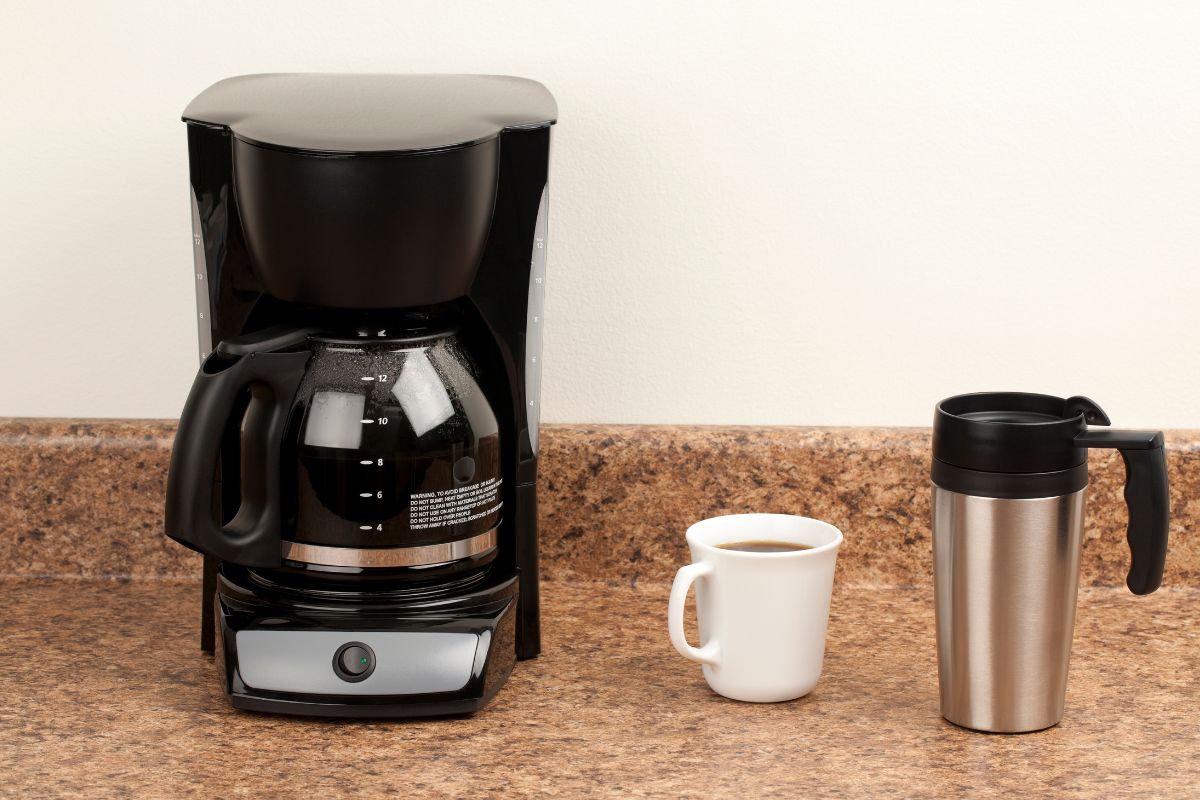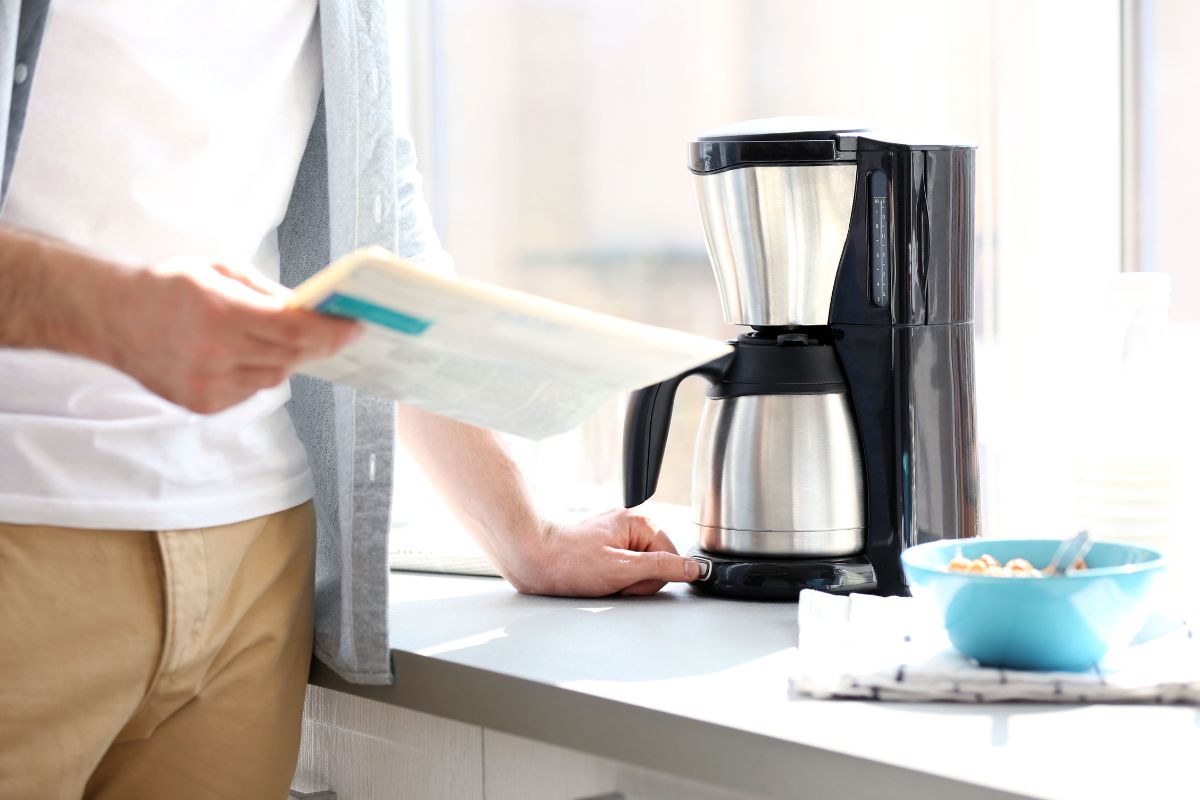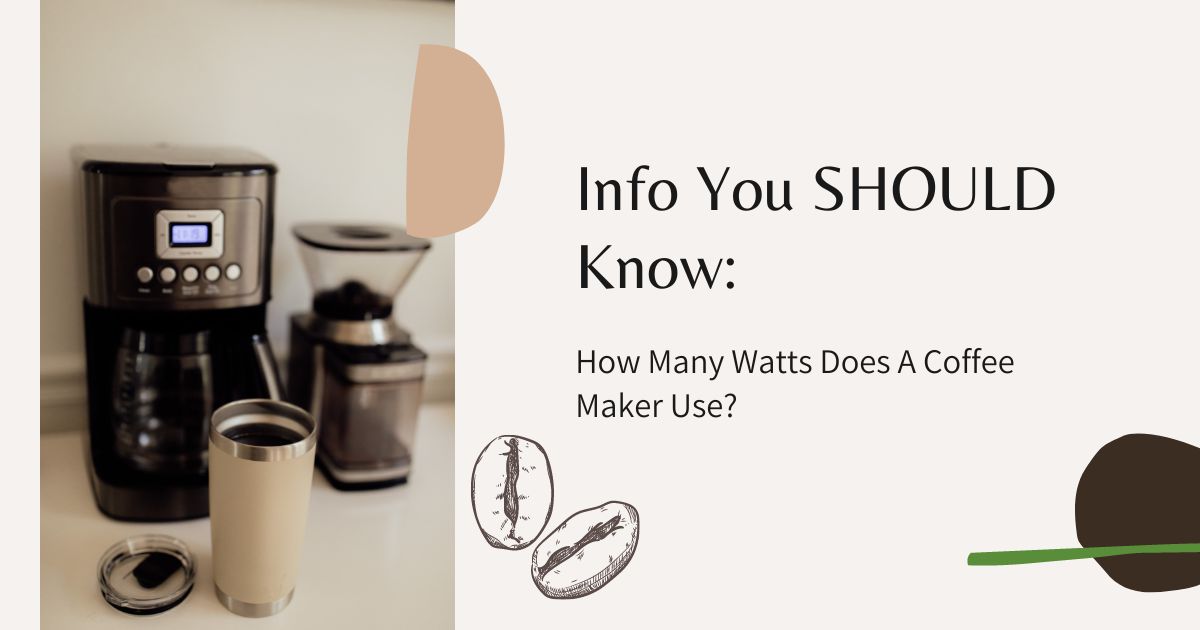Coffee Machine Watts
Machine and machine type affect the wattage of coffee makers. But how many watts does a coffee maker use? You can calculate the typical wattage of coffee makers and the typical for each machine type.
A coffee maker’s wattage is typically 1,317 w. 1,350 w is the standard coffee machine wattage. 2,090 w is the highest, and 650 w is the lowest wattage found. 46% of coffee makers have below-average wattages, while 53% are above-average.

The Low-Wattage Coffee Maker
How many watts does a small coffee maker use? A low-wattage coffee maker can use anything from 0 w to 1,200 w of power. The low-wattage category comprises thirty percent of the total number of coffee makers. The Bella Pro Series – 5-Cup Coffee Maker is an electric coffee maker with the lowest wattage, 650 w.
There are many modern models of coffee makers available, and most of them come with an energy-saving option that can help reduce the amount of electricity you use. After a predetermined amount of time, usually between half an hour and an hour, the device will power off thanks to this function.
Make sure you use this function even if you aren’t utilizing it for a long time since it will save you time. Before you make a purchase, you should check the product description or the manual to ensure that the model you intend to buy comes with the capability to use this option. You should never understate the importance of having a good coffee maker.
However, suppose you can track down the best coffee maker that uses a minimal amount of wattage. In that case, it will be child’s play to accomplish two goals at once: first, you will be able to enjoy a cup of delicious coffee, and second, you will be able to reduce your dependence on the power grid.
The Medium Wattage Coffee Maker
Coffee makers with a medium wattage can run anywhere from 1,201 w to 1,449 w. The medium wattage range accounts for 33 percent of all devices. The De’Longhi – DEDICA Espresso Machine, with its power output of 1,300 w, comes the closest to being typical among these options.
The High Wattage Coffee Maker
Coffee makers with high wattages often range from 1,450 w to 2,090 w or even higher. According to the survey findings, 37 percent of coffee makers fall into the high-wattage category. The Nespresso – De’Longhi Expert Espresso Machine is the household coffee maker with the greatest wattage recorded at 2,090 w.
However, the first model in the series only requires 1,260 w of electricity, making it a significantly more efficient appliance if you seek a comparable solution but use much less power.
Coffee Maker Wattage by Device Type
Kilowatt-hours, or kWh for short, are the units of measurement to determine how much energy it consumes over time. Now that we know the wattage, let’s examine the kWh coffee makers consume. For the sake of simplicity, let’s calculate the amount of electricity used over one hour and suppose that it utilized maximum power throughout the entire duration.
Simply dividing the wattage by 1,000 will get you the kWh equivalent (for an hour’s worth of use). The following table provides an overview of the coffee maker power consumption by various coffee makers for one hour at their maximum power consumption.
| Drip Coffee Makers | Single-Serve Coffee Makers | Espresso Coffee Machines | Combination Coffee Makers | All Coffee Makers | |
| Average | 1.25 kWh | 1.28 kWh | 1.40 kWh | 1.37 kWh | 1.32 kWh |
| Most common | 1.45 kWh | 1.26 kWh | 1.45 kWh | 1.35 kWh | 1.35 kWh |
| Highest | 1.70 kWh | 1.50 kWh | 1.80 kWh | 2.09 kWh | 2.09 kWh |
| Lowest | 0.65 kWh | 0.95 kWh | 0.75 kWh | 0.80 kWh | 0.65 kWh |
Now that we are familiar with the low, medium, and high wattage ranges, as well as the overall average wattage of coffee makers, let’s have a look at the wattage broken down by device type:
Drip Coffee Maker Wattage
The typical amount of wattage that drip coffee makers use is 1,253 w. A wattage of 1,450 w is present in most drip coffee makers. According to the study, a drip coffee maker has the lowest wattage of any coffee maker.
The Bella Pro Series – 5-Cup Coffee Maker has a wattage of 650 w, making it the drip coffee maker with the lowest wattage. In this particular category, 1,700 w is the maximum wattage that has ever been in existence.
Single-Serve Coffee Maker Wattage
A coffee machine that only makes one serving of coffee typically has a wattage of 1,282 w. The wattage of 1,260 w is the most typical for coffee makers that only prepare one serving at a time.
The wattage of the CHEFMAN – InstaCoffee Single-Serve K-Cup Pod Coffee Maker is 950 w, making it the single-serve coffee maker that has the lowest wattage overall. In this particular category, 1,500 w is the maximum wattage that has ever been in existence.
Espresso Coffee Machine Wattage
Notably, 1,402 w is the typical amount of power supplied by an espresso machine. A wattage of 1,450W is present in most espresso coffee machines. The Bella Pro Series – Pro Series Espresso Machine has the lowest wattage of any espresso coffee machine at 750 w. It is also the name of the device. In this particular category, the maximum wattage that has ever been is 1,800 w.
Combination Coffee Maker Wattage
The wattage output of a combined coffee maker is typically 1,368 w on average. The wattage of 1,350 w is the typical capacity for combination coffee makers. The Capresso – Steam PRO 4-Cup Coffee Maker and Espresso Machine has the lowest wattage of any combination coffee maker at 800 w. It also has the most cups per hour capacity.
The coffee maker with the 2,090 w wattage rating holds the record for the greatest wattage in this category, which includes 117 different models.
How Much kWh Does a Coffee Maker Use?
In the morning, most individuals get out of bed and immediately begin brewing a pot of coffee as part of their daily routine. Few people ever pause to consider the wattage of coffee makers and ponder about Keurig power consumption or how much money it might cost them in the long term.
There are a few things that you can do to lessen the influence that you have on the environment and your financial situation. The energy consumption of a traditional pour-over coffee machine is typically around 1000 watts. The primary purpose is to heat the water used to brew the coffee.
In most cases, brewing a full coffee pot requires between 4 and 5 minutes. The average energy used by your automatic drip coffee maker is 0.083-kilowatt hours; with one kilowatt-hour of power, you can create around 12 cups of coffee.
The Cost of Running a Coffee Maker
To operate a coffee maker at full capacity in the United States incurs an average cost of twenty cents per hour. In the United States, the most typical coffee maker has an hourly operating cost of up to 20 cents, with the lowest and highest running expenses, respectively, coming in at 10 cents and 31 cents.
To determine how much it costs to run your business, multiply the energy you use (measured in kWh) by the amount of money you spend per kWh. The following table estimates the costs associated with operating several types of coffee makers for one hour at their maximum power usage, assuming that the price of one kWh is 15 cents (the US average).
| Drip Coffee Makers | Single-serve Coffee Makers | Espresso Coffee Machines | Combination Coffee Makers | All Coffee Makers | |
| Average | $ 0.19 | $ 0.19 | $ 0.21 | $ 0.21 | $ 0.20 |
| Most common | $ 0.22 | $ 0.19 | $ 0.22 | $ 0.20 | $ 0.20 |
| Highest | $ 0.26 | $ 0.23 | $ 0.27 | $ 0.31 | $ 0.31 |
| Lowest | $ 0.10 | $ 0.14 | $ 0.11 | $ 0.12 | $ 0.10 |
Do Coffee Machines Guzzle a Lot of Energy?
Yes. The energy consumption of coffee makers is extremely high. The typical coffee maker uses a significant amount of electricity compared to other home appliances, given that it consumes 1.32 kWh of electricity per hour (at its highest setting). The quantity of electricity used by coffee makers, electric heaters, and treadmills with 2 horsepower is comparable.
When operating for one hour, the cost of the typical coffee maker is comparable to the cost of running a single load of laundry. Home appliances that heat the air or water are often considered wasteful energy.

A List of Energy-Efficient Coffee Makers
How many watts does a single-cup coffee maker use? It is not all about size. Some of the most popular electric coffee makers are also quite efficient in their energy usage. DC coffee machines and various stovetop coffee makers, in general, have the potential to be more energy efficient.
In a similar vein, using a French Press coffee maker in addition to a kettle may allow you to reduce the amount of energy required to prepare coffee. It depends entirely on the use case and how you want to use it.
The following table presents how wattage coffee maker compares among the best-selling coffee makers available in the market, along with a ranking of the best low-wattage coffee makers available:
| Coffee Maker Type | Lowest Wattage | Model |
| Drip | 650 w | Bella pro series-5 cup maker |
| Self serve | 950 w | Chefman-Instacoffee single serve K-cup pod coffee maker |
| Espresso | 750 w | Bella pro-series-Pro series espresso machine |
| Combination | 800 w | Capresso- Steam pro-4-cup coffee maker and espresso machine |
Tips to Reduce Coffee Maker Electricity Costs
- Unplug: Even when turned off, many coffee machines continue to use some amount of electricity. You may prevent waste by turning off your device and unplugging it when it is not in use.
- Only use it when necessary: In a manner analogous to standby, coffee makers continue to use electricity even while they are not in use, and many even heat up. This is a practical option when you want to make sure that you have coffee ready whenever you want it. Nevertheless, there is a considerable quantity of wasted electrical power. If you only use your device when necessary, you can help cut down on your monthly energy costs and overall carbon footprint.
- Consider upgrading to a more energy-efficient model: Many of today’s coffee makers have energy-saving features, such as an automatic shutoff function. If you have an older machine, you might want to think about purchasing a model that is more energy efficient.
- Reduce temperature: The heating process is when coffee makers use the most electricity. Bringing the maximum temperature down will result in energy savings. Why not use that function if it’s available on your machine?
- Consider changing energy provider: There is no need to alter your routine to take advantage of this speedy method for lowering your monthly expenditures. Utility companies frequently provide new customers with large price reductions, so it is in your best interest to search for the best deals. Look into different energy companies that give green energy options if you want to lessen your impact on the environment.
- Give some thought to getting gas and a French press: Compared to other methods, utilizing gas to bring water to a boil typically results in lower overall costs. Many different elements come into play, such as the quality of the kettle, but considering the lower price of gas, it is normally more cost-effective to boil water for coffee using gas. And even if you don’t have a French press, you can still make an excellent brew by using high-quality coffee and combining it with other ingredients.
- You might want to consider using an electric kettle: Electric kettles may be a more energy-efficient solution than other types of kettles and coffee makers, depending on how you utilize the coffee maker and kettle. There are a lot of different factors involved, so let’s compare these two choices after that.
Coffee Maker vs. Electric Kettle – Wattage Difference
Regarding the coffee’s overall quality, coffee makers typically produce coffee of a high standard almost immediately. You will probably need to use an additional appliance, such as a French press, to get the same coffee quality when making coffee using an electric kettle.
However, because most coffee machines use individual coffee pods, the overall cost of making a cup of coffee and its impact on the environment is likely higher. But what about the amount of energy that it consumes? Wattage can vary greatly among different brands and models of coffee makers and electric kettles. Electric kettles require, on average, 0.073 kWh for single use.
This figure considers the energy it loses when the kettle is more than full. This is significantly higher than the average consumption of a single-cup Dolce Gusto coffee machine, which is 0.03 kWh per cup. This figure is more than twice as high.
Because people who use electric kettles often fill them more than one cup higher than necessary, using electric kettles results in better energy efficiency. The difference in the amount of money spent on energy for single use of a kettle as opposed to a single cup brewed by a single-serve coffee maker is not significant, coming in at less than half a cent.
If you use your coffee maker or electric kettle only when necessary and turn them completely off when not in use, generally speaking (but it depends on the specific device), a coffee maker will be a more energy-efficient option for individual coffee drinkers than an electric kettle.
However, an electric kettle may be a better option for households with multiple people who drink multiple cups of coffee daily. This is mostly because it only heats the water necessary for each cup of coffee.
Electric kettles are not necessarily the most energy-efficient alternative, but if you have a good kettle and measure out exactly the amount of water you need, they can be. This is because coffee makers have the propensity to heat up when not in use and consume electricity while in standby mode.
Additionally, in contrast to electric kettles, coffee makers’ dispensing process requires electricity. If you aren’t careful about reducing your energy use, an energy-efficient coffee maker will probably be the best option when saving money on your utility bills.
On the other hand, using coffee pods will result in a greater overall cost per cup of coffee and an increased environmental impact.
Espresso Machine vs. Coffee Maker – Wattage Difference
Espresso machines are a subset of coffee makers; nonetheless, in this article, we will focus on contrasting them with other coffee makers. Espresso machines, on the whole, use significantly more electricity than other coffee makers.
The average wattage of a drip coffee maker is 1,253 watts, while the average wattage of a single-serve coffee maker is 1,282 watts. The average wattage of an espresso coffee machine is 1,402 watts. Compared to other coffee makers, an espresso machine’s energy efficiency is, on average, lower than that of other coffee makers.
Nevertheless, there are alternatives with a modest wattage. According to the research on 117 different coffee makers, the espresso machine with the second lowest wattage is the 750W Bella Pro Series – Pro Series Espresso Machine.
This machine is the second most energy efficient. Therefore, environmentally friendly espresso makers, particularly those that don’t require pods, have the potential to impact the environment less than other coffee makers.

A Final Word
How many watts does a single-cup coffee maker use? There is no one model of coffee machine that can claim to be the most energy-efficient choice for all consumers. It is dependent on the specific requirements of the individual as well as their behavior. The article takes you through the various available types of coffee makers vs. the coffee machine watts.
Besides, there are expert tips provided on how you can reduce your coffee maker wattage usage. By carefully choosing the best coffee maker machine and following these instructions, you will save heavily on power costs and become Mr.coffee wattage by having your favorite coffee and saving on the power cost.

